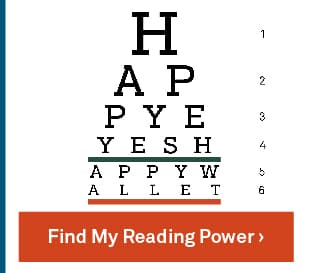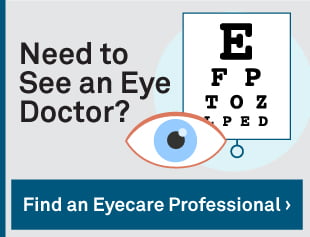Going for a routine eye exam is different than any primary care physician or dental checkup. Your first eye appointment might be a bit overwhelming, especially with the different eye tests your eye doctor might schedule during your visit. This information will prepare you for the various tests that could be administered, including dilation, glaucoma tests, and vision tests.
Cover test — With this test, the patient’s eyes are alternately covered while he or she focuses on a distant object. By looking at the eye’s movement as it focuses on the object, the optometrist can identify eye turn. Eye turn can lead to a lazy eye, poor depth perception, or other negative conditions.
Slit lamp test — The slit lamp examination is carried out with a biomicroscope that allows the optometrist to get a close look at the patient’s eyelids, cornea, iris, conjunctiva, and other internal structures. Cataracts and macular degeneration can be detected using this test.
Color vision testing —The color test entails looking at colored numbers that are formed out of dots. These colored numbers are against a background of a different color. People with normal color vision will see the number the way it is, whereas people with color vision problems may see an incorrect number. For example, a common mix up due to a color vision problem is seeing a “6” instead of a “5.”
Glaucoma — Glaucoma is a disease that is caused by having “elevated pressure in the eye.” This pressure usually leads to vision loss. (Please note that just because you have high eye pressure, you do not necessarily have glaucoma.)
Glaucoma often does not present any symptoms, so it is imperative to have a glaucoma test during your eye exams. If glaucoma is diagnosed early enough, vision loss may be prevented. There are six different tests that can help to diagnose Glaucoma:
- Tonometry — Tonometry is a test measures the patient’s pressure and is used to test for glaucoma. It often involves a painless puff of air directed at the eye. A machine will calculate the patient’s intraocular pressure (IOP) based on his or her eyes’ resistance to the air.
- Ophthalmoscopy — Ophthalmoscopy is a test that is used to examine the inside of the eyes by dilating the pupils. After the eyes are dilated, the eye doctor uses a magnifying lens to evaluate the color, shape, and health of the optic nerve.
- Gonioscopy — Gonioscopy is a test that uses a mirrored device to measure the angle of where the cornea meets the iris. How open or closed the angle is can be an indication of how severe the glaucoma might be.
- Visual Field — For this type of test, also known as perimetry, the patient has to stare at a light in the center of his or her field of vision. At the same time, other lights are shined into his or her peripheral vision. This test measures peripheral vision and can be used to detect the onset of open-angle glaucoma.
- Nerve Fiber Analysis — Nerve Fiber Analysis is a new test that measures the thickness of the nerve fiber. Thin nerve fiber is an indication of glaucoma. This test is best for someone who either suspects or knows they have glaucoma because it can measure if the disease is worsening.
- Pachymetry — Pachymetry is used to measure the thickness of the cornea, which can indicate the amount of pressure in the eye.
Dilation —When you visit the eye doctor, the optometrist will most likely dilate your eyes as part of the eye exam. Pupil dilation is important, as it allows the optometrist to examine the back of the eye, which is where important blood vessels are located, along with the retina and the optic nerve.
Pupil dilation is easily achieved through the application of dilating eye drops that force the pupil to stay open in bright light. While your eyes are dilated, your eye doctor will use a series of instruments to look inside of the eye. The dilation takes about 20 to 30 minutes, and many experience sensitivity to light for several hours. Dilation can make you feel disoriented and give you blurred eyesight. It is important to have someone drive you after your exam and to bring a pair of sunglasses to protect your eyes from UV damage while your pupil isn’t able to contract.
Resources on Different Types of Eye Exams
- All About Vision: What to Expect During a Comprehensive Eye Exam
- WebMd: Vision Tests
- All About Vision: Visual Field Eye Testing
- Glaucoma Research Foundation: Diagnostic Tests
- National Eye Institute: Facts about Glaucoma
- WebMd: Perimetry Test for Diagnosing Glaucoma
- Mayo Clinic: Glaucoma Tests and Diagnostics





2 Comments
winfred
Hi! I had an eye exam after detached
vitreous. They dilated me and did a slit light exam. After that
they inserted a metal probe between my eye ball and my eye socket yet
not under my eyelid but by simply inserting the probe from the
outside of the skin and pressing hard enough the probe and my skin
tissue are depressed between my eyeball and socket, like that, in
order to depress my eyeball so they could see in a difficult area I
think behind my iris. It was a very painful exam. I did not
complain. They want me back and appt in a few days. I have a large
floater but no detached retina and all looked good. My eyes hurt for
about 2 days. I took tylenol. I never complained and two Drs. did
the same probe exam in a row, one was a teacher and the other a
student Dr. The student Dr never washed his hands and also the metal
probe he carries around in his lab coat and it’s not sterile. Also
the second teaching Dr. borrowed the probe from the student to do the
same painful exam. I don’t want to complain but in a way I wonder if
this is all very invasive depressing the eyeball when they say all
looked good etc. What do you think, should I cancel my appt and just
keep vigilant for flashers and any “veils” of gray signs of
detachment and avoid that painful exam? The department nurse said
today not to cancel so I’m keeping the appt in only a few days. Also what is the name for this type of exam using such a probe so I can have an effective keyword to research this further.
Thanks for your attention.
Getting Tired
What you are describing is scleral depression, done to delineate between odd-looking areas of peripheral retina and a real retinal hole or break, which must be treated promptly with laser photocoagulation-to prevent a retinal detachment. Having practiced for 27 years, I can tell you that doing an exam with gloves on is much harder, and you can’t feel through the glove very well so you might push too hard.
This technique is the best way to examine the retina after a vitreous detachment since risk of retinal detachment rises dramatically after the vitreous detaches. While hand-washing between patients is a good idea, our hands don’t come in contact with anything besides the skin, which exists to keep bacteria and viruses out. The facial skin is typically covered with bacteria. the scleral depressor probably wiped some off your eyelids-an added bonus.
Getting a followup retina exam is very recommended. Once the vitreous detaches, it can take up to 8 weeks for retina tears to happen. If you just go home and only act if your vision gets blurred, you might have suffered what we call a macula-off retinal detachment, which can be fixed but your vision will be permanently ruined. Go to the followup and be proactive.
They say scleral depression is only a little uncomfortable. Baloney-it almost always hurts.